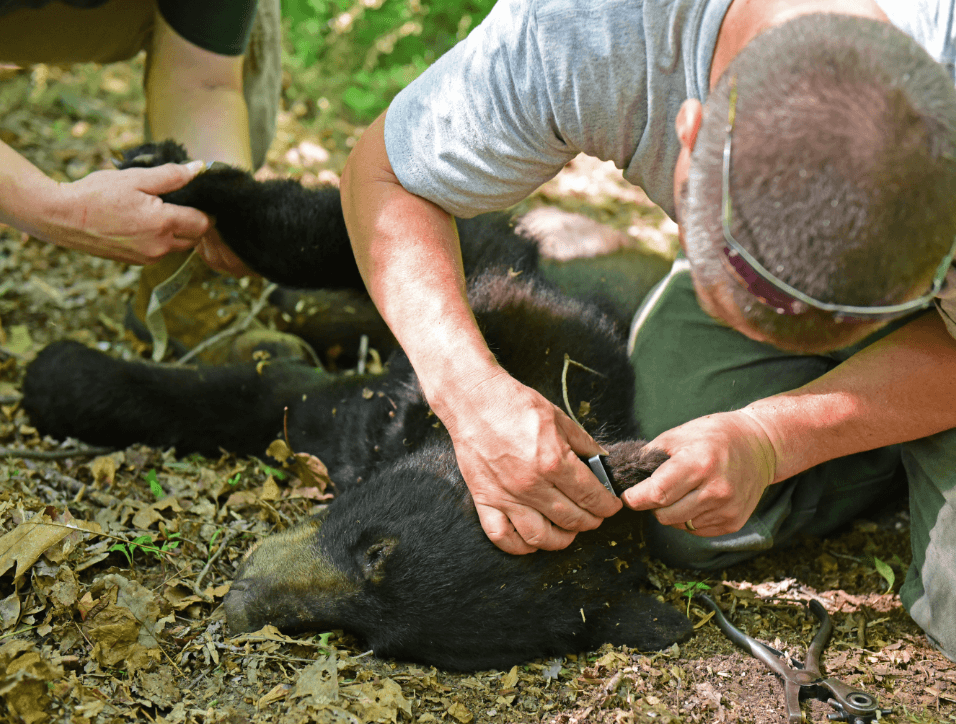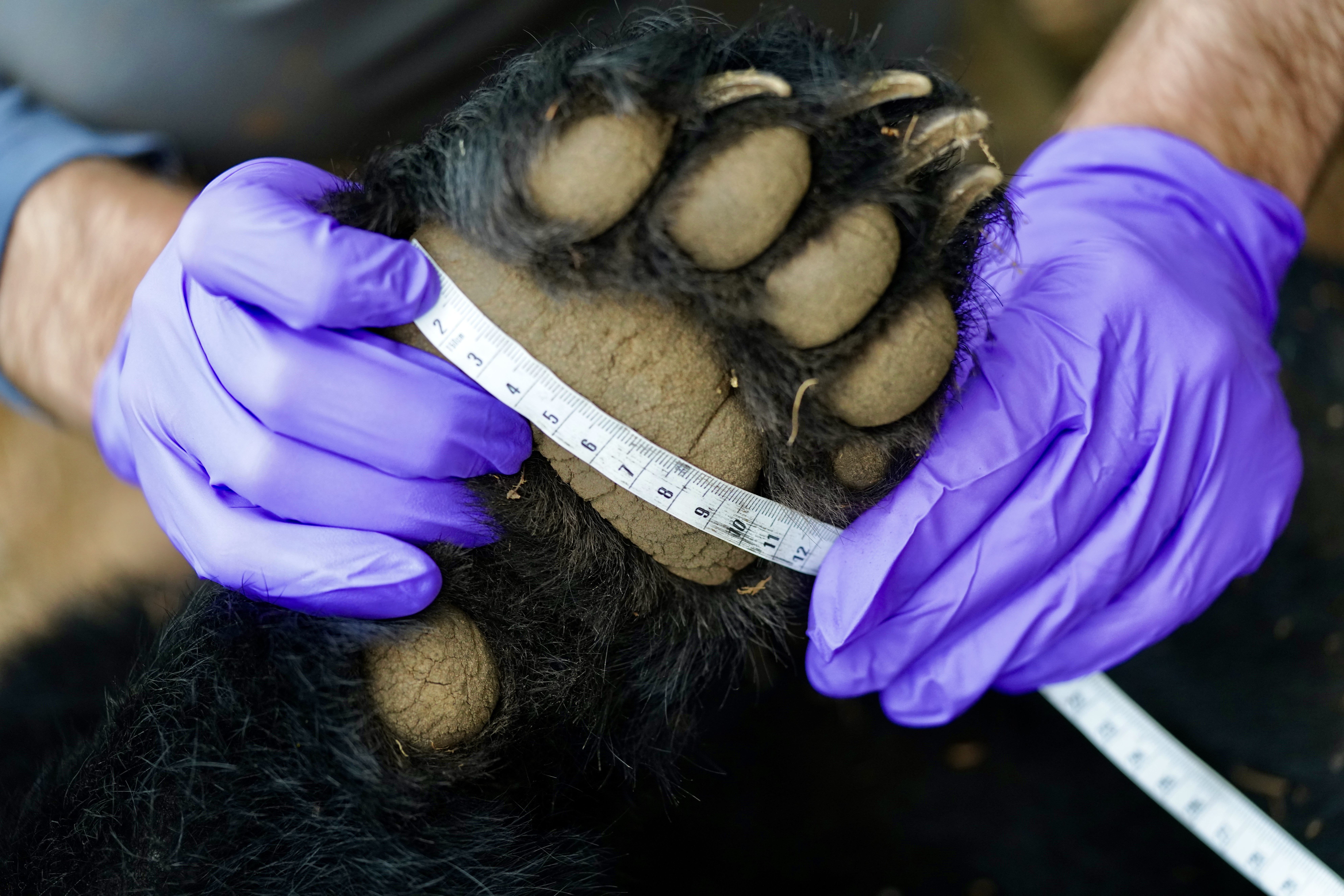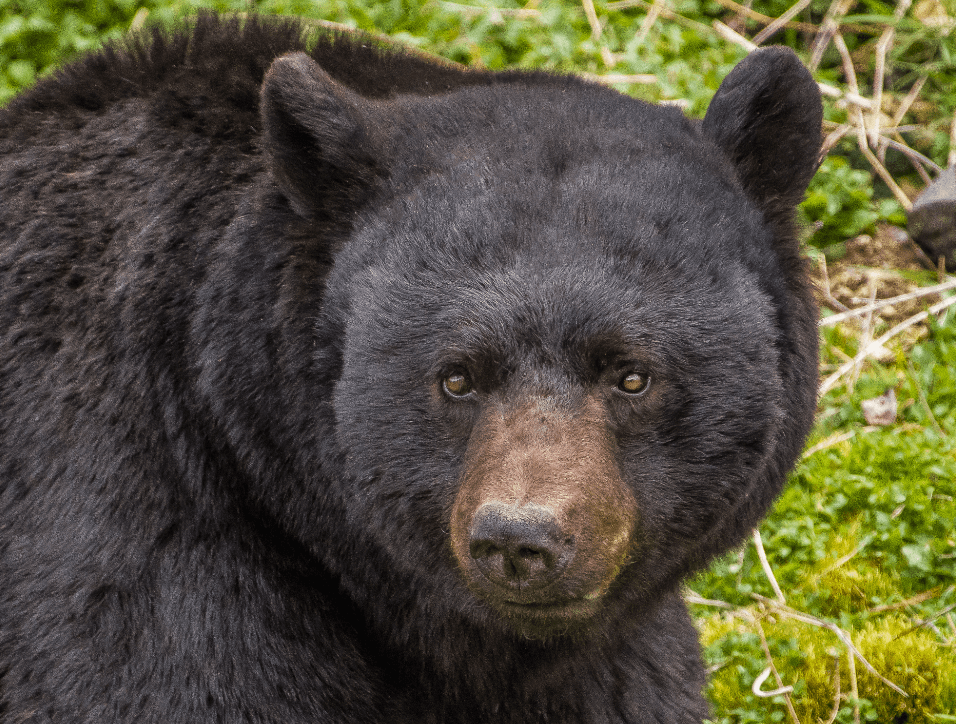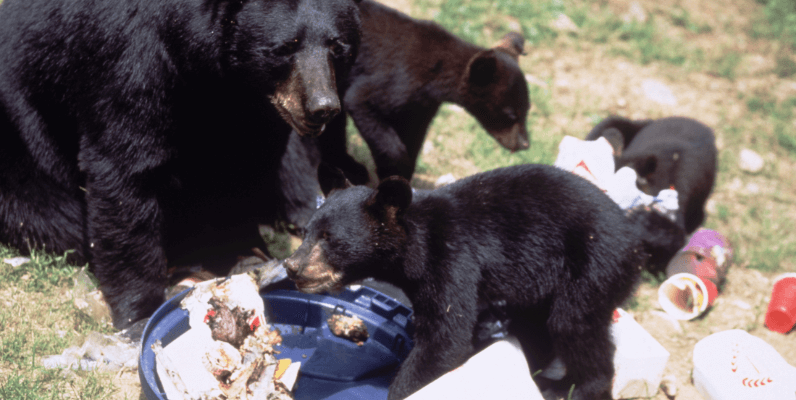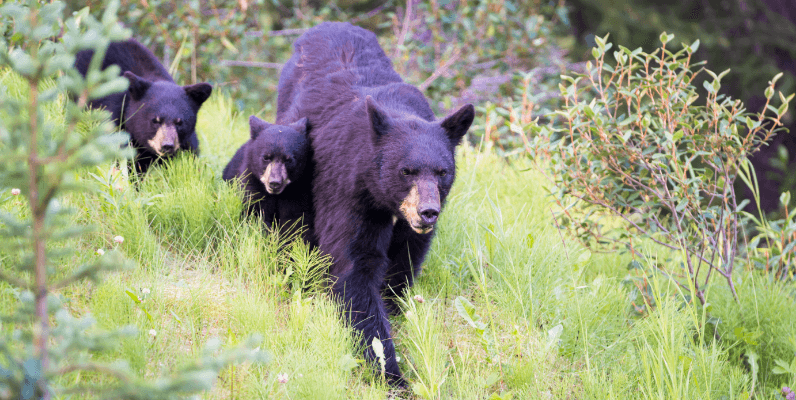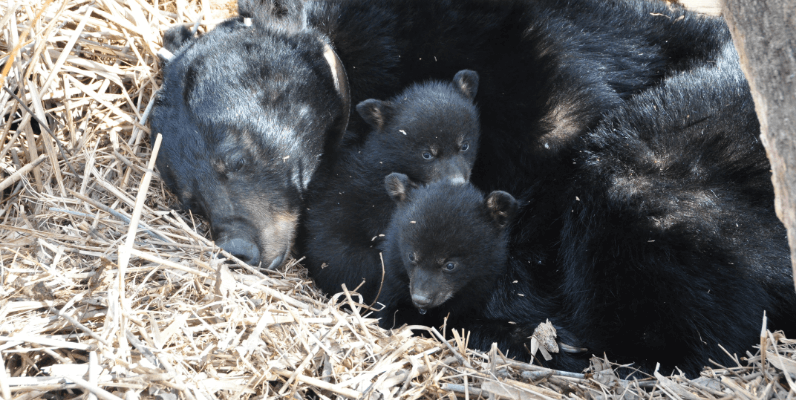Black Bear Research and Management
New Jersey Department of Environmental Protection’s Fish and Wildlife is responsible for protecting and managing New Jersey’s wildlife. In fulfillment of this responsibility, the agency is studying and managing a growing black bear resource while minimizing interactions with people.
Fish and Wildlife’s overall integrated bear management strategy includes public education, black bear research and monitoring, trapping and aversive conditioning, and euthanizing bears that pose a public safety threat.
Research Methodologies
In 1980, Fish and Wildlife personnel began conducting intensive research on New Jersey’s black bear population. In 2001, Fish and Wildlife’s Black Bear Project Team was created to intensify black bear management efforts. The black bear project team has been awarded the national Earnest Thomas Seton Award for excellence. After more than 30 years of research, personnel have handled approximately 3,500 individual bears. Fish and Wildlife has been conducting bear studies in the Kittatinny Ridge (Western) and Bearfort Mountain (Eastern) Regions. The Eastern Region comprises an area of approximately 350 square miles and the Western Region approximately 230 square miles. In 2007, the research study area expanded to include Bear Management Zone 4, which is west of I-287, south of I-80 and north of I-78. The entire research study area now encompasses 1,201 square miles.
Fish and Wildlife’s Black Bear Project uses three primary methods of research. These include research trapping and tagging, reproduction and recruitment work and radio telemetry studies. The data is collectively used to determine scientific population estimates, bear densities, breeding age and productivity, along with mortality and longevity of New Jersey’s black bears. Fish and Wildlife also partners with a number of cooperative research institutions such as East Stroudsburg University, Rutgers University and Montclair State University.
During research trapping and tagging, black bear project personnel capture and handle black bears in order to collect biological information and to estimate the population size in the research study area using mark-recapture methods. Research trapping for population monitoring takes place twice a year, in the fall and spring. The black bear project team works for nineteen consecutive days, trapping and collecting data on the animals.
Research trapping techniques include using Aldrich foot snares and culvert traps to capture black bears. Both types of traps commonly used by wildlife biologists and researchers employ humane methods of capture. Foot snares and culvert traps are baited with bacon, molasses and sweet scents to attract bears. Aldrich foot snares consist of a cable attached to a stout tree. When the bear places its front paw inside of the looped cable, a spring mechanism is triggered and the cable wraps around the bear’s paw. The bear maintains the ability to move 360 degrees around the tree and can even climb the tree to a certain extent. Culvert traps are barrel shaped traps that contain a bait bag. When the bear enters the culvert trap, a mechanism is triggered when they pull on the bait bag and the culvert door closes. Traps are baited and checked daily by Fish and Wildlife personnel.
When caught, black bears are chemically immobilized with darts containing an anesthetic and analgesic solution. Once sedated, bears that have never been caught before receive metal ear tags which display an identification number. The identification number is also tattooed onto the inside upper lip of the animal. Additional biological information is collected on all trapped bears. Measurements are taken on parts of the bear to determine growth rates and productivity in sows. Measurements include head circumference, head length, body length, girth, paw and leg measurements and teat length on sows. The bears are also weighed using a scale with a pulley system. A tissue sample is collected from the ear for DNA analysis (such as paternity studies) and blood samples are collected to look for diseases, such as West Nile Virus and Toxoplasmosis. The pre-molar tooth is extracted to determine the bear’s age. Once cross-sectioned and stained, rings, called annuli, are visible and can be counted like a tree ring to determine age.
When biologists obtain a dead black bear, such as one killed in a vehicle collision, they may collect additional biological information from the bear when conducting a necropsy. Biologists may look at the stomach contents for food studies, the diaphragm to look for diseases like Trichinosis and reproductive tracts to determine the number of litters a sow may have produced.
During research trapping, sows may be fitted with radio-collars and monitored by radio telemetry to gather information on reproduction, survival, mortality, home range size and habitat use. Throughout the year, Black Bear Project personnel track collared sows on foot using a hand-held antenna with a radio-receiver. The receiver detects the radio-frequency from a transmitter on the collar, which is emitted as a pulsed signal. The exact location of the animal is then determined by homing towards the signal or by using triangulations to calculate the location.
In the spring of 2008, Fish and Wildlife began to track sows using satellite collar transmitters. This allows biologists to evaluate the effectiveness of aversive conditioning by studying the movements of collared nuisance bears. The satellite collars send information through satellites to a ground-based computer tracking system in order to accurately determine the animal’s location.
During January, February and March, staff from the Black Bear Unit conduct den research to document reproduction and recruitment into the population. Personnel track bears to various den sites using radio-telemetry. Boars and sows in dens are chemically immobilized and biological information is collected. Sows are also checked for cubs of the year. In March, when cubs of the year are large enough in size, they are tagged with metal ear clips, weighed and measured.
Management Measures
In addition to the Fish and Wildlife’s black bear research and monitoring and public education campaign, personnel implement wildlife control measures to manage nuisance black bears. The Bear Response Unit staff are biologists and technicians trained in wildlife management techniques. They are available to provide advice to callers with minor bear problems and technical assistance to homeowners, beekeepers and agriculturists with serious damage problems.
The Bear Response Unit personnel, who are certified in firearms use and chemical immobilization, also actively trap and aversively condition bears responsible for recurring nuisance incidents. A 2009 study of aversively conditioned bears (study abstract – pdf; full study – pdf) found that all of them returned to an urban setting within 17 days after release. Three of the five conditioned bears were observed in dumpsters or entering a dumpster. Based on these findings, the aversive conditioning protocol at best is beneficial in keeping bears temporarily away from the location where they were conditioned. However, it does not eliminate nuisance behavior in black bears. Personnel will euthanize bears that show unyielding or aggressive behavior and pose a threat to public safety, or that do not respond to the conditioning process. Fish and Wildlife personnel have trained nearly 1,550 police officers and park rangers in bear response.
In November 2000, Fish and Wildlife began implementing the current Black Bear Rating and Response Criteria (BBRRC). The BBRRC is the operating policy for response to bears that are a threat to human safety, agricultural crops, property or are a nuisance (Adapted from Black Bear Policy Committee 2005). The BBRRC defines three categories of black bear behavior and dictates how the New Jersey Department of Environmental Protection and local law enforcement should respond.
Black Bear Category Rating Criteria
| Category I | Bears which are a threat to public safety and property. |
| Category II | Nuisance bears which are not a threat to public safety or property. |
| Category III | Bears exhibit normal behavior and are not a nuisance or threat to public safety. |
The following tables describe the different responses taken by Fish and Wildlife based on a bear’s category classification:
Category I Black Bears
| Description | Examples | NJ Fish & Wildlife Response |
| Black bears exhibiting behavior that is an immediate threat to human safety, those causing agricultural damage to farmland or property damage over $1,000. | Human attacks, home entries, attempted home entries, tent entries, agricultural crop damage and attacks on or kills of protected large and small livestock, beehives or pets. | These bears are euthanized as soon as possible to protect the public or eliminate further damage to agricultural crops or property. |
Category II Black Bears
| Description | Examples | NJ Fish & Wildlife Response |
| Nuisance black bears which are not a threat to life or property. Property damage of less than $1,000. | Habitual visits to garbage containers, dumpsters or birdfeeders. Attacks on or kills of unprotected large and small livestock. Damage to unprotected beehives. | These bears are aversely conditioned using rubber buckshot and pyrotechnic charges so that they receive a negative experience associated with the nuisance location and people. If trapped, nuisance bears are released on site and aversely conditioned. |
Category III Black Bears
| Description | Examples | NJ Fish & Wildlife Response |
| Black bears exhibiting normal behavior and not creating a threat to the safety of the public or being a nuisance. In general, these are animals observed and reported to NJ Fish & Wildlife’s Bear Response Unit by the public or local authorities. Such animals may be considered by the caller to be a danger or a nuisance because the caller has not had the experience of interacting with bears. | Dispersing animals that wander into densely populated areas (see Urban Bears below), black bears passing through rural and suburban neighborhoods and black bears observed by hunters, hikers, campers and others using facilities in black bear habitat. Category III bears may occasionally use birdfeeders and trash containers as supplemental food sources in the course of their activities. Until a Category III black bear returns to a particular site and repeats utilization of these food sources, it is not considered to be a nuisance or problem animal. (Category II). Injured/diseased and orphaned/abandoned bears are also considered Category III bears. | The Black Bear Response Unit offers assistance in the form of technical advice on bear-proofing surroundings to callers reporting Category III encounters. No attempt is made to capture a Category III bear unless it is confined in a fenced area or treed in an urban area during daylight and any further movement will result in a threat to safety of the public or the animal due to potential vehicle collision. |
Urban Bears
| Description | Examples | NJ Fish & Wildlife Response |
| Black bears that have wandered into densely human-populated areas. | These may be young bears dispersing from their mother’s territory, or bears traveling in search of food, water, or habitat. | NJ Fish & Wildlife will respond to urban bears based on whether they are displaying Category I, II, or III behavior. |
Injured/Diseased Bears
| Description | Examples | NJ Fish & Wildlife Response |
| Black bears that appear to be wounded or sick. | Bears that exhibit injuries or behavior that prevent them from functioning properly. May also include extreme hair loss and/or neurological symptoms. | Depending on the condition of the bear, it may be left alone, captured or euthanized by NJ Fish & Wildlife. |
Although the Fish and Wildlife and the New Jersey Fish and Game Council are committed to advancing the science of non-lethal population control measures for black bears, at this time there is no FDA approved contraceptive drug or sterilization drug available for bears. The New Jersey Department of Environmental Protection commissioned a study to assess the present status and the feasibility of using fertility control agents, including contraceptive drugs, sterilization drugs and surgical sterilization on black bears in New Jersey. For more information, see the October, 2006, DEP Div. of Science and Research report, An Analysis of the Feasibility of Using Fertility Control to Manage New Jersey Black Bear Populations.
Additional Links
Fish and Wildlife Biologists Perform Winter Den Research (NJ.com Video)
New Jersey Black Bear Status Report 2011 (pdf)
An Evaluation of Black Bear Management Options – Northeast Black Bear Technical Committee (pdf)
 Official Site of The State of New Jersey
Official Site of The State of New Jersey


